Special to Transport Topics
Automated Transmissions Shift Into High Gear
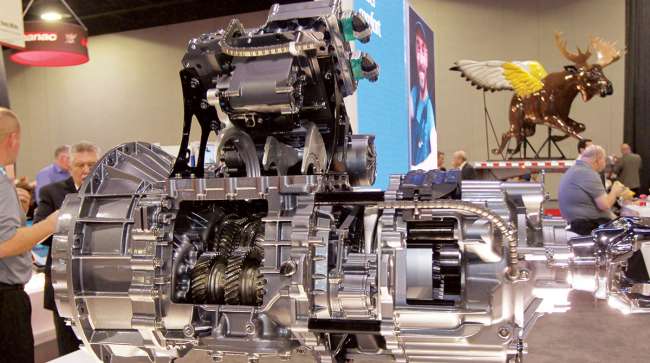
[Stay on top of transportation news: Get TTNews in your inbox.]
A notable shift in the types of transmissions used in fleets’ Class 8 trucks has occurred over the past five years. Manual transmissions reigned as king among fleets and seasoned truck drivers for decades, but they now represent a minority that is rapidly shrinking.
NFI recently converted nearly its entire 2,600-vehicle fleet to automated manual transmissions. “We started the transition at end of 2014, into 2015, and then made it standard in our fleet,” said Bill Bliem, NFI senior vice president of fleet services. “We probably have less than 10 [manuals] now.”
Camden, N.J.-based NFI ranks No. 19 on the Transport Topics Top 100 list of the largest for-hire carriers in North America.
The trend toward AMTs is evident throughout the industry, and market penetration is upward of 80%, according to representatives from Eaton Cummins, an AMT manufacturer. Eaton Cummins Automated Transmission Technologies was formed in April 2017 as a 50-50 joint venture between Eaton Corp. and engine maker Cummins Inc. to produce automated transmissions for medium- and heavy-duty trucks.
Volvo Trucks North America reports an AMT share of about 93% for all of the transmissions it manufactures. Daimler Trucks North America introduced the Detroit DT12 AMT in 2014 and currently reports a 90% adoption rate among its Freightliner Cascadia truck models.
The transition has occurred quickly, said Mike Roeth, executive director of the North American Council for Freight Efficiency. In 2014, NACFE published a confidence report predicting swift adoption of AMTs, and that phenomenon occurred within a year.
“Three years ago, it went over the tipping point where AMTs were only about 30% of the market, then they jumped to about 70% almost in one year,” Roeth said. “I was nervous about us forecasting that big jump, but we predicted it.”
That’s around the time Ozark Motor Lines expanded its use of AMTs. It put five units into service for testing in December 2013, purchased 10 more in 2014 and started to convert the entire fleet by March 2015. This year, the company will come close to finishing the process.
“I wish we had started converting the fleet a little sooner,” said Glen McDonald, director of maintenance at Ozark. “We really like them.”
NACFE estimates fleets experience 1-3% fuel economy gains with AMTs compared with manual transmissions. Automated manuals mimic the practices of the best manual drivers, thus evening out performance across a fleet and eliminating less-efficient shifting.
AMTs took a while to catch on but now have become the norm because of their advantages in the over-the-road tractor market, Roeth said. Fleets and manufacturers report that AMTs officially have replaced manual as the standard transmission option.
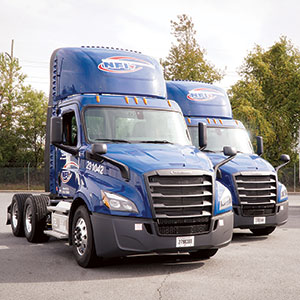
NFI recently converted nearly its entire fleet to automated manual transmissions. ATMs now are standard for the fleet. (NFI)
“We’re seeing increased fuel economy, lower maintenance costs and happier drivers,” NFI’s Bliem said.
Replicating best shifting practices reduces the necessary maintenance due to less stress and wear on the clutch and other shifting components. Fleets also report reduced driveline failures and tire wear.
Maintenance costs “absolutely have gone down,” Ozark’s McDonald said. “Before, the driver would push the accelerator and [the transmission] would give them what they asked for. Now when they push it, the engine and the transmission talk and give them what they need.”
In addition, across the board, those in the industry cite driver recruiting and retention as a key benefit of converting from manual transmissions to AMTs, an especially important factor amid a driver shortage.
Younger drivers, in particular, are drawn to AMTs because they have less experience with manual transmissions when they enter the industry due to the prevalence of automatic transmissions in personal vehicles.
Even truck driving schools are embracing the shift.
“A lot of the schools are training on automated transmissions instead of manuals now,” said Steve Sichterman, vice president of client services for Conversion Interactive Agency. “They’re hiring drivers that actually have automatic transmission-only endorsements on their CDLs.”
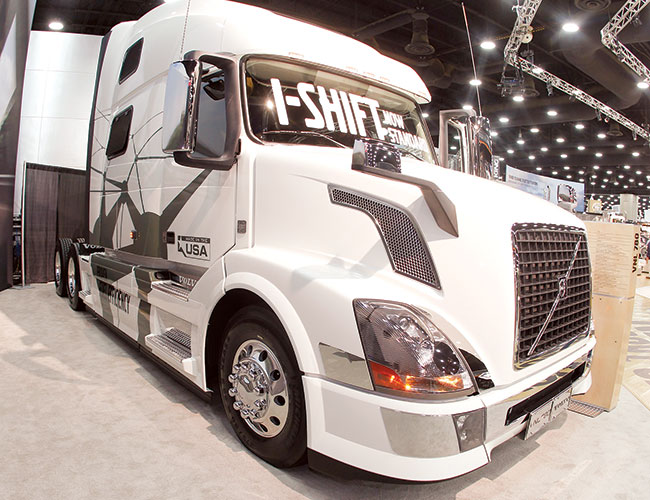
A Volvo truck equipped with the I-Shift automated manual transmission. Volvo Trucks is on the third version of its proprietary I-Shift. (John Sommers II for Transport Topics)
Engine and transmission connectivity is “another big deal” that’s driving AMT adoption, said Ashley Murickan, product marketing manager at Volvo. “Many fleets and OEMs are going to complete integrated solutions. Engines and transmissions are usually offered as an integrated solution.”
Volvo incorporates its proprietary I-Shift AMT into its vehicles. The company is on its third iteration of the I-Shift.
Because the same engineers design Volvo’s engines and transmissions, the two have seamless communication. “This transmission knows the engine-efficiency maps and predicts all the best shift points all the time,” Murickan said.
For example, in models with an active driver-assist collision mitigation system, the transmission will downshift by itself when the system detects the potential for a collision. “If you were driving a manual transmission, it might not necessarily be the case that you would downshift because you’re concentrating on braking the vehicle,” Murickan said.
Eaton Cummins also integrates predictive features into its transmissions. For example, its predictive cruise control system allows for better shifting decisions when a vehicle climbs a grade.
“Essentially, the transmissions are able to see the road ahead and make a decision about what’s coming,” said Charles Ganske, product strategy manager at Eaton Cummins. “You wouldn’t have that in a manual and the driver would have to do that themselves, so it’s definitely an improvement from a drivability standpoint.”
Eaton Cummins introduced the Endurant AMT in 2017 and recently expanded some of its features. Endurant is available in Paccar and Navistar vehicles, with plans to expand to additional OEMs.
And when it comes to driver recruiting, fleets use AMTs as a selling point because they are easier to use and less strenuous for drivers. The less physical nature of shifting reduces driver fatigue and allows drivers to work later in life. It also opens the profession to people who might possess less strength, such as women or a person suffering from an injury.
As is often the case when transitioning from manual transmissions to AMTs, management at NFI and Ozark initially experienced pushback from seasoned drivers who believed manuals are better and safer. But acceptance at both companies happened quickly when drivers tried AMTs.
NFI’s Bliem said drivers now like AMTs so much that they don’t want to give one up and resort to a manual if a truck must go out of service for maintenance. Both businesses also found AMTs to be as safe as manuals, even in snowy or icy conditions.
Although AMTs have experienced significant growth, torque converter automatics — often referred to as fully automatic transmissions — have made more modest gains. Some in the industry, such as Volvo’s Murickan, suggest the sector has reached a plateau. About 1% of Volvo’s transmissions are automatics. Estimates for torque converter automatic penetration across the trucking industry vary but generally hover around less than 10%.
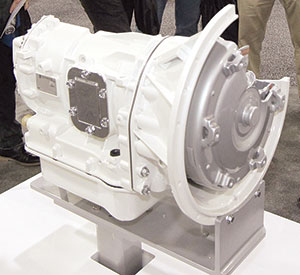
An Allison fully automatic transmission on display at an industry meeting this year. Allison does not offer ATMs or manual options. (John Sommers II for Transport Topics)
Allison Transmission is the main company offering fully automatic transmissions for OTR trucking in the U.S. It does not offer AMTs or manual options, only torque converter automatics. The company reported a 4% net sales increase in this year’s second quarter compared with the second quarter of 2018.
It recently announced the introduction of a medium-duty 9-speed transmission, which builds on the fuel efficiency, performance and durability of the 6-speed model.
“We believe very strongly there are benefits to having this power shift capability,” said Richard Price, Allison Transmission’s executive director of Customer Integration and Application Engineering. “The torque converter allows a fluid coupling in the drive line. As such, we’re able to use that fluid coupling for very fine maneuvering at low speeds.”
In Class 8 trucks, that means better maneuvering with automatics than with AMTs when backing toward a trailer or loading dock. NFI, for example, initially experienced issues with trailers jumping while backing after switching to AMTs, and drivers had to adjust their operating procedures.
Torque converters also take full engine torque to help launch a vehicle, Price said. “If you have to come to a stop on a hill, your chances of getting started with an automatic are much better than with a manual or AMT.”
Industry analysts suggest the growth in automatics primarily lies in the vocational sector, such as garbage trucks, fire trucks or construction vehicles. OTR trucking has not necessarily experienced the same adoption rate because automatics’ efficiency and other benefits are more evident in stop-and-start work environments.
While some analysts point to automatics’ slightly higher efficiency, AMTs tend to be lighter, which aids fuel efficiency. Volvo estimates its AMT is about 100 pounds lighter than a fully automatic.
Weight reduction is one thing Allison is working on with its automatics, Price said.
Fleets don’t necessarily believe the benefits outweigh the increased up-front cost of an automatic compared with an AMT, which tends to be several thousand dollars.
Although AMTs still cost more than manuals, fleets experience better value for AMT trade-ins. That’s a stark change from a few years ago when AMTs were viewed as a liability on the back end.
“The value is now built into it,” Ozark’s McDonald said. “That tells me the secondary buyer is interested in [AMTs], too.”
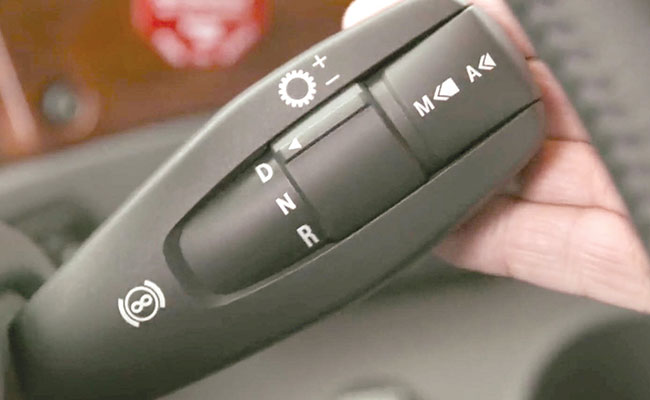
Gear selector of the Detroit D12 automated manual transmission. (Freightliner.com)
Despite AMTs’ higher initial cost compared with manuals, motor carriers find them more valuable in the long run.
“It’s a balancing act. If you know you need to hire more drivers and this is something that’s going to attract them, it’s an investment rather than a price point, particularly with the larger fleets,” said Sichterman, of Conversion Interactive Agency.
Because of AMTs’ market success, Eaton Cummins and Volvo don’t anticipate greater expansion into torque converter automatics. Likewise, NFI and Ozark are satisfied with the performance of their AMT, and don’t expect to switch to automatics.
Volvo does, however, anticipate the day is approaching when the company won’t manufacture manual transmissions anymore, Murickan said.
“I think this is about the last time we’ll be talking about manuals versus AMTs,” said NACFE’s Roeth, who added that “talk of AMTs versus automatics will continue.”

